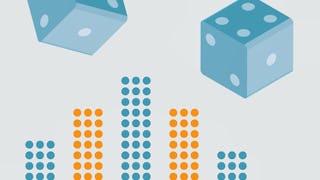This course will provide you with a basic, intuitive and practical introduction into Probability Theory. You will be able to learn how to apply Probability Theory in different scenarios and you will earn a "toolbox" of methods to deal with uncertainty in your daily life.

Enjoy unlimited growth with a year of Coursera Plus for $199 (regularly $399). Save now.

An Intuitive Introduction to Probability

Instructor: Karl Schmedders
88,734 already enrolled
Included with
(1,881 reviews)
Skills you'll gain
Details to know

Add to your LinkedIn profile
32 assignments
See how employees at top companies are mastering in-demand skills

There are 5 modules in this course
In this module we will learn about probabilities and perform our first calculations using probability formulas. We want to get comfortable with the idea that probabilities describe the chance of uncertain events occurring.
What's included
7 videos1 reading7 assignments
The arrival of new information may lead us to alter our probabilistic assessments of uncertain events. In this module, we will learn how the concept of "conditional" probabilities allows us to make these changes correctly. Script of the course can be found here: https://www.coursera.org/learn/introductiontoprobability/resources/qxi9W
What's included
6 videos1 reading6 assignments
We will discuss some fascinating every-day applications of probability. In addition to entertaining examples, we will also review very serious applications from finance and law.
What's included
6 videos6 assignments
In this module we move beyond probabilities and learn about important summary measures such as expected values, variances, and standard deviations. We also learn about the most popular discrete probability distribution, the binomial distribution.
What's included
8 videos1 reading8 assignments
We want to get comfortable with the normal distribution. We will discuss what the famous bell curve really represents. And we will learn how easy it is to calculate normal probabilities.
What's included
6 videos1 reading5 assignments
Instructor

Offered by
Explore more from Probability and Statistics
 Status: Free Trial
Status: Free TrialJohns Hopkins University
 Status: Free Trial
Status: Free TrialBirla Institute of Technology & Science, Pilani
 Status: Preview
Status: PreviewJohns Hopkins University
 Status: Free Trial
Status: Free TrialDuke University
Why people choose Coursera for their career




Learner reviews
1,881 reviews
- 5 stars
81.45%
- 4 stars
15.30%
- 3 stars
2.07%
- 2 stars
0.47%
- 1 star
0.69%
Showing 3 of 1881
Reviewed on Sep 9, 2021
This is an excellent course! This course really aims to give everyone a sense what the probability field covers and does not get lost into too much detail yet. I enjoyed it very much.
Reviewed on Mar 22, 2023
It's a great course, loved the way Prof. Karl Schmedders explains things. However one area of improvement of this course is - the methods adopted in the exercises needed to be covered in the lectures.
Reviewed on Nov 2, 2017
This course is an absolute GEM. I am glad I took it before my CFA preparation. I would highly recommend this course . I thoroughly enjoyed all the real time applications given by the professor!!!

Open new doors with Coursera Plus
Unlimited access to 10,000+ world-class courses, hands-on projects, and job-ready certificate programs - all included in your subscription
Advance your career with an online degree
Earn a degree from world-class universities - 100% online
Join over 3,400 global companies that choose Coursera for Business
Upskill your employees to excel in the digital economy
Frequently asked questions
To access the course materials, assignments and to earn a Certificate, you will need to purchase the Certificate experience when you enroll in a course. You can try a Free Trial instead, or apply for Financial Aid. The course may offer 'Full Course, No Certificate' instead. This option lets you see all course materials, submit required assessments, and get a final grade. This also means that you will not be able to purchase a Certificate experience.
When you purchase a Certificate you get access to all course materials, including graded assignments. Upon completing the course, your electronic Certificate will be added to your Accomplishments page - from there, you can print your Certificate or add it to your LinkedIn profile.
Yes. In select learning programs, you can apply for financial aid or a scholarship if you can’t afford the enrollment fee. If fin aid or scholarship is available for your learning program selection, you’ll find a link to apply on the description page.
More questions
Financial aid available,

